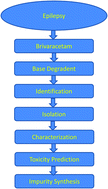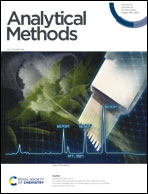Identification, isolation, structural characterisation, synthesis and in silico toxicity prediction of the alkaline hydrolytic degradation product of brivaracetam by using LC-PDA, preparative HPLC, LC/HESI/LTQ, FTIR, and 1H NMR
Abstract
Brivaracetam is a racetam derivative of levetiracetam with very limited data available on its degradation behaviour. An official HPLC method for brivaracetam has not been published yet to resolve the degradation products generated during stability studies. Therefore, an isocratic reverse phase HPLC-UV method was developed for the determination of brivaracetam in the presence of its related impurities and degradation products. Efficient chromatographic separation was achieved on an Inertsil ODS 3 V, 150 mm × 4.6 mm, 5 μ column with the mobile phase containing a mixture of 0.1% v/v trifluoroacetic acid solution and acetonitrile (60 : 40 v/v) at a flow rate of 1.0 ml min−1 with the eluent monitored at 210 nm. The proposed method was validated as per the ICH Q2 (R1) guidelines. The method was validated for specificity, linearity, precision, accuracy and robustness. For the assay, the calibration plot was linear over the concentration range of 141 μg ml−1 to 262 μg ml−1 of brivaracetam with a correlation coefficient (r2) of 0.99981. For the study of related substances, the calibration plot was linear over the concentration range of 0.0147 μg ml−1 to 2.93 μg ml−1 of brivaracetam with a correlation coefficient (r2) of 0.99994 and 0.0148 μg ml−1 to 2.96 μg ml−1 of the base degradation product of brivaracetam with a correlation coefficient (r2) of 0.99994. The proposed method was used to investigate the degradation kinetics of brivaracetam under different stress conditions. The drug was found to be less stable under basic degradation conditions. The method shows consistent recoveries for brivaracetam (100.22% at the 70% level, 100.02% at the 100% level and 99.14% at the 130% level of the test concentration i.e. 200 μg ml−1 of brivaracetam). The method was found to be accurate, precise, linear, specific, sensitive, rugged, robust, and useful for characterizing the stability of the drug molecule. The marketed formulation (brand name: Briviact) was analysed by using the proposed method; we have carried out identification, isolation, structural characterisation and in silico toxicity prediction of the alkaline hydrolytic degradation product of brivaracetam by using LC-PDA, preparative HPLC, LC/HESI/LTQ, FTIR and 1H NMR. The predicted alkaline degradation product was found to be 2-(4-methyl-2-oxo-1-pyrrolidinyl) butyric acid (i.e. a brivaracetam acid impurity generated after alkaline hydrolysis of brivaracetam). In silico toxicity prediction was carried out by using the eMolTox webserver. The synthesis of isolated impurities of brivaracetam has also been carried out successfully.



 Please wait while we load your content...
Please wait while we load your content...